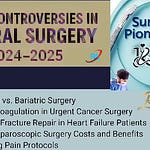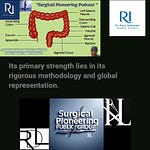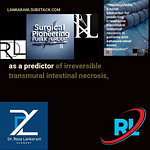Reviewed by Reza Lankarani M.D
Volume 282, Number 1, July 2025
DOI: 10.1097/SLA.0000000000006192
Annals of Surgery
Summary:
This prospective cohort study by Remy et al. (2025) presents a significant contribution to gender-affirming surgery by rigorously evaluating the novel technique of Targeted Nipple-Areola Complex Reinnervation (TNR) during double-incision mastectomy with free nipple grafting (FNG). The primary strength lies in its comprehensive, prospective design, meticulously tracking sensory outcomes (quantitative monofilament testing and patient-reported questionnaires) in 25 patients (50 mastectomies) at multiple time points up to 12 months postoperatively. This longitudinal approach robustly demonstrates that TNR facilitates restoration of NAC and chest sensation to baseline within 3 months, with significant *improvement* over baseline observed at 12 months – a finding with profound implications for patient quality of life. Furthermore, the study provides crucial, previously unavailable anatomical data on intercostal nerves (ICNs), confirming comparable axon/fascicle counts across branches (3rd-6th lateral ICNs) and establishing a median of 2 nerves utilized per mastectomy. The analysis linking surgical technique to outcomes is particularly valuable; it conclusively shows that direct coaptation of ≥2 ICN branches to the NAC yields superior and faster sensory recovery compared to using allografts alone or coapting only a single branch.
Methods:
Twenty-five patients (50 mastectomies) were prospectively enrolled between 2021 and 2022. Data collected included demographics, surgical technique, and axon/fascicle counts from a subset of patients (n=15). Quantitative sensory evaluation was performed using Semmes-Weinstein monofilaments preoperatively and at 1, 3, 6, 9, and 12 months postoperatively. Qualitative patient-reported questionnaires on sensation, pain, and satisfaction were also administered at various postoperative time points. The study evaluated the influence of intraoperative nerve anatomy, axon and fascicle counts, and nerve repair techniques (direct coaptation vs. allograft) on sensory outcomes.
Results:
A median of 2 ICN branches were found and used per mastectomy.
Preoperatively, a higher Body Mass Index (BMI \ge30 g) and mastectomy weight (\ge800 g) were associated with significantly worse sensation.
Postoperatively, NAC sensation was initially worse at 1 month but comparable to preoperative values at 3, 6, and 9 months, and significantly better at 12 months. Chest sensation followed a similar trend, becoming significantly better at 12 months.
Direct coaptation of the ICN to the NAC resulted in significantly better NAC sensation compared to using allografts only.
Utilizing two or more ICN branches for direct coaptation led to superior sensory outcomes compared to a single branch.
At 12 months postoperatively, 95.6% of patients had equal or improved NAC monofilament values, and 100% had equal or improved chest skin sensation.
Patient-reported outcomes showed good subjective return of sensory functions, with 88% of patients reporting a return of some degree of erogenous sensation at 12 months post-surgery.
Nipple hypersensitivity decreased over time, from 42% at 3 months to 8.0% at 12 months. Chronic pain was reported in 32% of patients throughout the study period, decreasing to 10% at 12 months, while phantom pain was absent at 12 months.
It demonstrates TNR effectively restored NAC and chest sensation within 3 months postoperatively. The study concluded that using multiple ICN branches and direct coaptation techniques yielded the best sensory outcomes.
Key findings include:
• Restoration of sensation : 95.6% of patients showed equal or improved NAC sensation at 12 months compared to preoperative baseline, with 88% reporting erogenous sensation recovery.
• Technical advantages : Direct coaptation of ≥2 intercostal nerve (ICN) branches yielded superior sensory outcomes compared to allograft-only techniques.
• Reduced chronic pain : Only 10% of patients reported chest pain at 12 months, significantly lower than historical rates (27.3%) post-GAM.
• Anatomic insights : Axon and fascicle counts across ICN branches were comparable, suggesting flexibility in donor nerve selection, though the 4th and 5th ICNs were most consistently viable.
The study underscores TNR’s potential to mitigate common postoperative complications of GAM, including sensory loss, phantom pain, and chronic neuropathic discomfort.
Strengths:
Innovative Technique Evaluation : This is the first prospective study to quantify sensory recovery following TNR in GAM, addressing a critical gap in gender-affirming surgical outcomes. Prior work focused on oncologic breast reconstruction 17–20, leaving GAM-specific reinnervation understudied.
Prospective Design: The prospective nature of the study provides a higher level of evidence compared to retrospective reviews, allowing for systematic data collection and follow-up.
Comprehensive Sensory Evaluation: The use of Semmes-Weinstein monofilaments provides an objective, quantitative measure of light touch sensation, while the patient-reported outcomes capture the subjective experience of sensation, including erogenous sensation, which is highly relevant to patient satisfaction after GAM. The inclusion of measures for nipple hypersensitivity, chronic pain, and phantom sensations further enhances the comprehensiveness of the sensory assessment.
Detailed Anatomical and Technical Analysis: The study provides valuable insights into the intraoperative anatomy of ICNs, their axon and fascicle counts, and the impact of different nerve repair techniques (direct coaptation vs. allograft) on sensory recovery. The finding that direct coaptation and the use of multiple ICN branches lead to superior results is a crucial technical refinement for surgeons.
Addressing a Clinically Relevant Issue: Loss of sensation, particularly in the NAC, is a well-documented and often distressing consequence of traditional GAM with FNG. This study directly addresses this functional and psychological deficit, offering a promising solution that could significantly improve the quality of life for transgender patients undergoing these procedures.
Long-term Follow-up: A 12-month follow-up period allows for a more robust assessment of sensory recovery, as nerve regeneration can be a slow process. The observation that sensation continues to improve beyond 3 months and is significantly better at 12 months suggests ongoing neural plasticity and recovery.
Learning Curve Analysis: The acknowledgment and demonstration of a learning curve associated with ICN dissection and coaptation, showing a decrease in allograft use over time, is a transparent and important aspect for surgical training and practice.
Comparison with Latest Studies:
The field of nerve reconstruction in breast surgery, particularly for gender-affirming procedures, is rapidly advancing. Remy et al.'s work builds upon and contributes to this growing body of literature.
Pioneering Multi-Nerve Coaptation: The study's emphasis on utilizing multiple nerves to enhance sensation by maximizing donor axon counts is a significant differentiator. Previous research on chest and breast reinnervation, especially in oncological breast reconstruction, often focused on single nerve coaptation. Remy et al.'s findings strongly support the hypothesis that increasing the number of nerves coapted to the NAC leads to enhanced sensory outcomes. This principle of maximizing axon counts aligns with general peripheral nerve surgery tenets.
Return of Erogenous Sensation: The high rate (88%) of reported return of some degree of erogenous sensation at 12 months is particularly noteworthy. This is a critical aspect of body autonomy and satisfaction for many patients undergoing GAM. While some studies in breast reconstruction have noted the return of sensation, specific detailed reporting on erogenous sensation outcomes has been less prevalent. This outcome is highly patient-centered and contributes significantly to the understanding of functional recovery beyond light touch.
Rochlin et al. (2020): Found improved NAC sensation in GAM patients undergoing immediate TNR, validating Remy et al.’s findings. However, Rochlin’s retrospective design lacked standardized sensory testing, highlighting the current study’s methodological rigor.
Minimally Invasive Surgery (MIS) Trends : While the article focuses on open GAM, recent advances in MIS (e.g., robotic-assisted techniques) emphasize reduced postoperative pain and faster recovery.
Phantom Sensation Literature : The study reports lower phantom pain rates (0% at 12 months) compared to post-mastectomy cohorts (13.3%), suggesting TNR may mitigate afferent signaling disruptions. This aligns with MIS literature showing reduced phantom phenomena via nerve preservation.
Nerve Coaptation Techniques : Findings support the growing consensus that maximizing donor axon counts enhances sensory restoration, a principle now applied in implant-based breast reconstruction.
Future Directions :
Comparative trials against pedicle-sparing techniques and integration with MIS platforms could refine TNR’s role. Additionally, exploring cortical reorganization post-TNR using neuroimaging might elucidate mechanisms behind erogenous sensation recovery.
In conclusion, Remy et al. have provided robust prospective data supporting the efficacy of targeted nipple-areola complex reinnervation in improving sensory outcomes after gender-affirming mastectomy with free nipple grafting. The study's strengths lie in its detailed methodology and comprehensive sensory assessment, particularly its focus on multiple nerve coaptation and patient-reported erogenous sensation. While generalizability might be limited by its single-center nature and lack of a concurrent control group, this research undoubtedly sets a new benchmark for sensory preservation in GAM and will serve as an important reference for future studies and clinical practice. Further multicenter studies with larger cohorts and longer follow-up are warranted to solidify these promising findings and refine surgical protocols.
M.D#sensoryoutcomes #nipple-areolacomplex #reinnervation #doubleincisionmastectomy #freenipplegraft #breastreconstruction #nervepreservation #breastsurgery #sensoryrecovery #mastectomytechniques #nipplesensation #breastcancersurgery #reconstructivesurgery #nerveregeneration #aestheticbreastreconstruction













Share this post